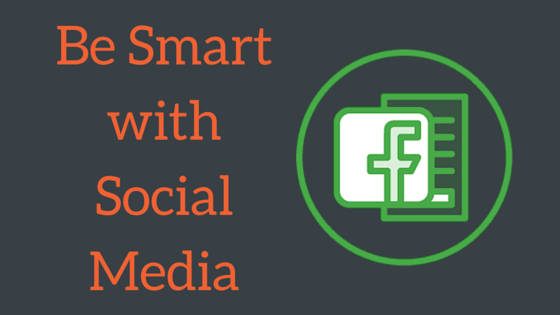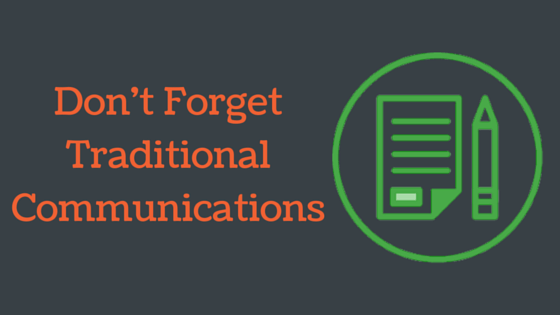
Abby Jarvis
Today, Abby Jarvis is back with 3 more ways to promote your online donation page. You can find the first 3 strategies here. Be sure to tell us which one is your favorite in the comments below. ~Kristina
Guest Post by Abby Jarvis of Qgiv
Last week, we talked about the first 3 strategies for marketing your online donation page:
1. Segment Your Donors
2. Educate Your Supporters
3. Send Great Emails
Today, we finish up with:
4. Be Smart with Social Media
5. Don’t Forget Traditional Communications
6. Improve Your Website
4. Be Smart with Social Media

Alongside email, social media stands as a powerful digital marketing tool that can lead donors to your online donation form.
You could write whole volumes about social media strategy and the best practices for posting status updates, photos, videos, and other content.
Not only does social media marketing cover a lot of ground, social networking is constantly changing (we’ve just recently seen two big updates for Facebook and Instagram users).
How can you stay ahead of the curve?
Well, you can start by researching where your donors are interacting.
If you have an overwhelming number of supporters who use Facebook, you should focus your efforts there.
If your donor pool doesn’t have a lot of Twitter users, consider shifting your strategy away from that platform.
As far as posting on social media goes, stay within the following guidelines for the best success:
Post the link to your online donation page
This point may seem fairly obvious, but you’d be surprised how many nonprofits simply forget to link their online donation page to their social media accounts.
You should link out to your online donation page within your posts, of course, but you can also place your link in the designated information section on your account.
Collect donations on Facebook
Facebook has piloted their own donation button with 19 national nonprofits including The Red Cross and the American Cancer Society.
But, for smaller nonprofits and organizations that weren’t included in that original rollout, there is a solution.
Services like Qgiv’s allow nonprofits to place a donation form within their Facebook page.
When donors click the link, they are taken to the same donation form that they would find on your nonprofit’s website. The only difference is that they haven’t left Facebook!
Post varied content at opportune times
Just like with emails, there are good times and not-so-great times to post on social media.
Social media users generally follow these patterns:
- Facebook: Weekdays from 1 p.m. to 4 p.m., particularly Wednesdays at 3 p.m.
- Twitter: Weekdays from 1 p.m. to 3 p.m., especially Mondays.
- Pinterest: Saturday mornings and Friday at 3 p.m.
These are just general guidelines; you may find that your donors interact with your nonprofit during different times of day. Check your Facebook insights and interaction trends you see on Twitter to make sure you’re speaking to your online audience when they’re on those channels.
Additionally, your content should be varied enough to capture the interest of each of those segments we talked about in point #1.
Post success stories, donation appeals, and general info to appeal to all groups.
Social media can seem like an untameable beast sometimes. But if you can narrow your focus and post content you know your donors will be interested in, you’ll start seeing results.
**Bottom Line** Social media is a powerful marketing force. Use it to effectively drive traffic to your online donation page!
5. Don’t Forget Traditional Communications

Nonprofits still need to send out direct mail appeals, newsletters, and cards to appeal to donors who prefer a more traditional fundraising route.
But that doesn’t mean that these methods should be ignored as marketing strategies for your online donation page.
How can you properly promote your donation form on these communications?
- Include the URL to your website and information about donating online within your mailed newsletters (tip: make your URL as short and simple as possible to make navigating to your page as easy as possible!).
- Let donors know that they can give online when you call them.
- Get donors’ feedback about their online experience when you talk to them in person during meetings and at events.
- Promote your online donation page on banners, flyers, and other promotional items at events.
It’s important to remember that donors who receive direct mail aren’t necessarily opposed to donating online. There will still be some supporters who want to mail in their checks and give over the phone, but don’t exclude these marketing channels as ways to promote your online donation page.
**Bottom Line** Don’t forget about traditional communication methods to reach out to donors. You can still drive traffic to your online donation page with these offline outreach strategies.
6. Improve Your Website

In the past, online revenue has increased by 13% thanks to a 32% jump in monthly giving and a 17% increase in web traffic.
Those numbers are only set to grow!
But donors won’t know how to give online if your website isn’t optimized for their experience.
Let’s look at some easy ways to improve your website to increase the chances that donors will give online:
Make your donate button prominent
While your website is meant to be a hub for your nonprofit’s news, resources, events, and updates, it’s also one of the easiest ways for donors to give to your cause.
Don’t make them hunt for your donate button!
It should be easy for donors to reach your online donation page regardless of whether they’ve just landed on your homepage or are 20 months back in your blog archive.
In your site-wide navigation, try using a contrasting (but complementary!) color on your donate button to make it stand out from other items.
Make it mobile-responsive
Some of your donors will be accessing your website on their smartphones and tablets.
Does your site look just as great on these smaller screens?
If not, it might be time to invest in a mobile-responsive website. Otherwise, your donors might be pinching, scrolling, and zooming, becoming more and more frustrated.
Tell your story but include donors in that narrative
Donors want to know that they’re giving to a worthwhile cause.
You want to assure them that your mission is worth supporting.
And while your nonprofit’s story is likely very compelling, it’s a good idea to include your donors in that narrative.
Letting donors know how they can be a part of your organization is vital for connecting with them and ensuring that they donate.
Your nonprofit’s website should reflect this integrated story.
These three tips are by no means the only website optimizations that you can perform. They will, however, increase the chances that donors who arrive on your site will go on to donate.
**Bottom Line**Make your website a positive experience for your donors. They’ll be more likely to end up on your donation page!
We’ve tried to hit the high points in these articles, but there are undoubtedly many more marketing techniques that can drive donors to your online donation page.
What strategies has your nonprofits used? Which methods worked and what fell flat?






